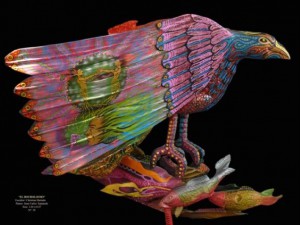SACRED BREATHWORK ™ MUSIC THEORY MODULE
By Mikkal
The Sacred Breathwork music theory is schooled in the Grofs’ music protocol, but departs in some significant ways, and where it departs it follows the structure worked out on ritual leadership and ritual process in my books ‘Psychotherapy and the Sacred’, and ‘Jung and Shamanism in Dialogue.’
We live in a vibratory universe. The shaman’s healing, ceremonial, or teaching work is a matter of attuning the patient, student, or community to his/her vibratory frequency which is centered in the Initiation Process. The shaman initiates the patient into the same realms s/he was initiated in. Shamanic apprenticeship is also an initiation involving a transformative vessel or womb, and death and rebirth process, and a reintegration process. It follows the 3 Phase- Rites of Passage, or Hero Journey Structure outlined by Van Gennep, Eliade, Turner, and J Campbell and R. L. Moore:
1) Separation, 2) Descent/Initiation, 3) Return to the ordinary world.
To evoke and support ritual trance, holotropic states are needed. They are those non-ordinary states that evoke rite of passage type trance by shamans for purpose of dance, initiation, diagnosis, or healing processes. There must be sonic driving in Phase 1), for example, and this must not have silent pauses called “air” in sound technology trade. Each tune must be faded into the succeeding tune throughout the three phases.
Sacred Breathwork Music selections are gathered and sorted into separate files or folders according to suitability for Ritual Phase 1), 2) or 3). Label your folders by phase. You should ongoingly gather good music which you continually pre-sort into these folders, and later select from it sequence your tunes.
I also use Phase O for Invocation.
Phase 0: The Call (to Adventure or Initiation) begins with an induction meditation (progressive relaxation and grounding) with smudging and sometimes an invoking prayer or chant. The invoking prayer should suggested connecting with the Divine Spirit, Inner Healer, Inner shaman, or other name for the Wholeness-Making Force. Ask its help. Surrender to it, trust it, honor and follow it.
Phase 1: Separation for ordinary consciousness is evoked via strong volume, rapid, and continuous percussive and rhythmic music selections. Aesthetics may also be considered, but strong sonic driving to produce entrainment is essential. These sonic vibrations, along with connected breath rhythm, activate the holotropic process, and of the pain body cleansing process, with “kryias” and catharsis and odd postures arising. The heaviest breathing and entrancing takes place usually during this phase, and not infrequently BPMs, COEX, and gestalt-sequences are initiated, often with rebirthing. Phase 2 often activates BPM II engulfment & BPM Struggle III. Music should be selected accordingly, very active in the beginning and towards the end of the phase calming down. But the phase should end with a tune that has an emotionally cathartic emotional feeling tone to it…perhaps vocal (not English) where the lungs and voice belt out with feeling. This can facilitate catharsis of any built up tension. Time allowed. Up to 70 minutes.
Phase II: Descent/Initiation: This phase is generally calmer (LESS RHYTHMIC AND PERCUSSIVE, MORE MELODY AND CHANTING) and more centering music and is supported by “numinous” music in the first half of this 2nd phase, such as Kirtan-Bhakti music, choral music, to usher in the sense of being in the presence of the Sacred Source-level of Being—the safest place to open the heart, surrender to self-healing holotropic forces implicit in the psyche. The Sacred is Whole-making. Individuals will often assume worshipful yoga “asanas,” prayer mudras, lie prostrate, communicate with the ground of Being—heal their relationship to the Divine, which is the deepest of Whole-making experiences. From their they may explore old traumas, past lives, finish business with dead loved ones, forgive, and make fundamental life changes, achieve fundamental insights that are healing or liberating. The second half of the 2nd phase can include a non-vocal movie music, with archetypal or epic themes to sweep for any archetypal-drama elements that may be close to the surface and want to come up with a little support. The music may be classical, soft didge, Tibetan bowls, with an emotional upsurge music piece for catharsis of the tension that may have been building up towards the end of this phase. After playing an emotionally moving selection to permit catharsis, the music should then wind down in volume and become tranquil and centering. Time allowed, 45-60 minutes.
Phase III Return: This phase involves a gentle return to body, nature, and to OSC waking consciousness, as much as possible, and is supported by music that has earth sounds, such as whales and water, waves, night sounds like crickets and frogs, bird sounds, sounds of wind, crackling fire, perhaps some mellow didge. Volume should be occasionally phased down, and when three hours are up, go to zero, keeping silence to allow people to come back. Suggested Time allowed, 10-20 minutes.
Other Considerations:
No talking during mandala art phase, as this can prematurely bring into verbal consciousness.
No music after the ceremony, as this can pull people back into trance, and it is time for them to become grounded and back in OSC.
I recommend downloading iTunes to organize and play your music during Sacred Breathwork.
iTunes can be explore for sacred/numinous music, percussive, shamanic drumming, chanting, kirtan, and so on. I use iTunes and Garage Band for organizing my music lists and running them during breathwork–but music gathering itself comes from many sources, including the sharing or trading with friends, and many music websites where you can find free or very cheap to purchase downloads (See Jason Beer’s comments on audio file quality below).
There are a variety of free download mixers from the internet to overlap and fade music.
You can make your own sound tracks with programs like Garage Band.
Avoid disco tunes. Avoid unnatural synthesized music in most cases.
Avoid familiar classics of pop, disco, or classics. Explore the music world acoustically for interesting and entrancing sounds and emotional qualities.
Avoid shallow music that makes you want to dance, but not introspect or look within.
Forget rave music.
Don’t use psychologically startling or unsafe music that creates fear, like loud Thunder Claps, or explosions, or hammering.
Play your music a lot, and notice emotions they evoke in you.
Drop your tunes in folders labeled 1) 2) and 3) according to suitability of phases.
Then order and organize the tunes according to the protocol I outlined above.
At graduation you will need your three hour sacred breath sound track. All graduates may trade with each other, so you will have 10 sets or so.
You should have at least 100 tunes, divided amongst the three folders.
Brian Ohm is available for doing the tech work of fading and taking out the ‘air’ for a reasonable fee, but you must find and order your own sequences according to the theory and protocol above.


I want to add a comment on the short length of phase three–from a comment I shared with Lyn: “Grof doesn’t require that (earth sound music in Phase III) and gives an hour to the 3rd Phase. I shorten it, and lengthen the first and second to maximize transformative experience, and gradudate the second phase down with calming centering music before I shift to phase 3 earth sounds–that’s why it is shorter, people only need a gentle call at that point.” -Mikkal
Some additional stuff I’ve been thinking about that goes with ensuring induction of an NOSC via music is the space and ambiance of the room. Candlelights streamed across the room in strategically placed safe spots (as Mikkal does) helps.
Future considerations for those who are serious about conducting these workshops . . . Controlling for sound reflection in the room, to prevent a “reverb chamber” would be beneficial. This is relevant because the brain can get caught up in identifying and labeling sound reflections (i.e., staying busy with the music, preventing deep trance states). This can be avoided, covering at least 25% of the room’s wall surface with an absorptive material can soak up sound reflection. A “thick” drape could aid in this. Also, strategically placing the speaker in a spot that allows for the whole room to receive an equal amount of bass. Bass trapping is a way around this also. You can create your own or make a purchase . . . here’s a YouTube video for how to create your own.
http://www.youtube.com/watch?v=iyYUpkpL0gw
Here’s a website with decent pricing on bass traps: http://www.audimutesoundproofing.com/acoustic-bass-trap-corner-bass-traps-a-bass-trap.aspx
Obviously those who facilitate breathwork workshops in a permanent setting may have it easier to include these things in their sacred space than someone who travels to a site. These are just some things I’ve been considering to include in my future work facilitating breathwork. It’s important to note that NOSC can occur with or without these materials assistance if the music is and participant’s mind is right/ripe for the experience.
Good input Jason–there are a wide number of music sites in other countries also, like the Siberian and Bulgarian music I have. Sounds quality opf recordings, and state of the art sound system with a good sub-woofer is also very important. Sound quality definitley matters.
Could I also add, as an audiophile, that we should all be looking for music files with high quality sound.
In my opinion, something like iTunes is great for organization, but the music you can buy on their site is not the greatest of quality.
A quick lesson: most of the stuff on itunes is now around 192 – 256 kbps on an AAC or MP3 file. But what we should really be looking for are at least 320 kbps AAC or MP3 files.
What is even better than MP3’s are Apple Lossless files (or some other form of Lossless file – which means no quality is lost). One common way to get Apple Lossless is to buy the CD, rather than a digital download, and upload the files into iTunes as Apple Lossless files (go into preferences, import settings). They go anywhere from around 500 to 1000 kbps. These are the highest quality one can have – they are a bit more compressed than WAV files (compressed meaning slightly less space is taken up on your drive, WAV meaning pure quality). FLAC is also a compressed file, which you can find on download sites and transfer via programs to Apple Lossless files (I will neither deny nor confirm that I support this, but can give info to those who are curious).
Better sound quality increases the experience of the music – more conscious for those with ears for it, more unconscious for those without… either way it affects us differently. Make an investment for yourself, your clients, as well as the rest of us and our clients, and go for the better quality! 🙂
If you are looking for CD quality AIFF is the way to go. Thats 16 bit, 44.1K. Apple Lossless is actually not lossless. They do compress the file by almost half. The higher quality mp3s or AAC will usually suffice.
Thank you also, Nick, for your technical input. I am sure people will want to tap the technical audio knowledge of you, Jason, Brian and Angela on this music technology stuff.
Good call Nick, youre absolutely right. Apple lossless is a bit compressed, thus not totally lossless like WAV or AIFF; but I thought there wasnt a difference in quality due to the type of compression of AL vs MP3. However, I could be wrong, just something I read a while back. Thanks for pointing out!